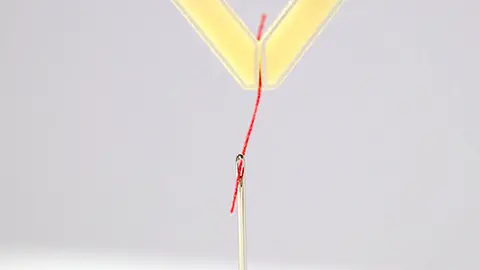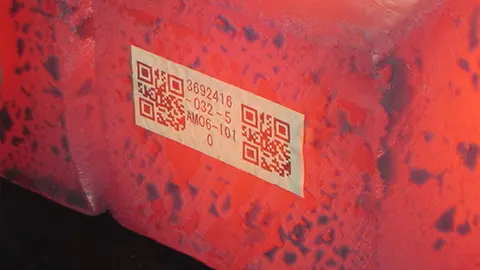VOL.194 JULY 2024
JAPANESE SMALL AND MEDIUM ENTERPRISES LEADING THE WORLD
One of the World’s Lightest Fabrics Woven from Ultra-Fine Threads Measuring 1/40th of a Millimeter
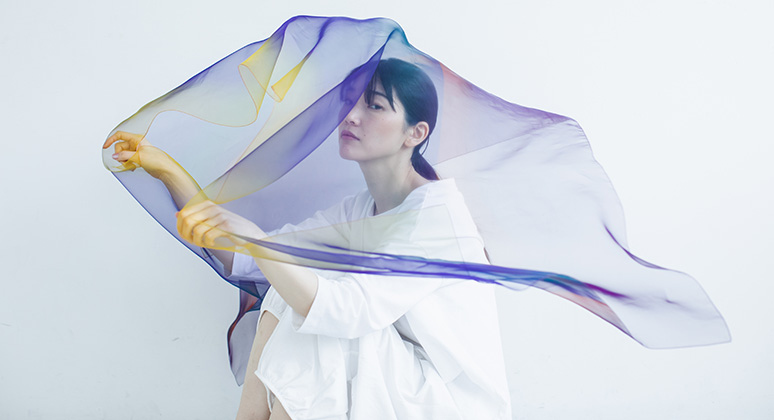
This ultra-lightweight and extremely thin fabric, developed by Amaike LLC, is known in Japan as ‘Tennyo no Hagoromo’ (feathered robe of a heavenly maiden) and internationally as ‘Amaike Super Organza.’
Photo: KOMATSU MATERE Co., Ltd.*
Ultra-fine thread, approximately one-fifth the thickness of a human hair, is so delicate that it can be cut off by static electricity, making it extremely challenging to weave into fabric. Amaike LLC spent several years developing the weaving technology for this ultra-fine thread. This thin, lightweight, and shiny fabric has captivated fashion brands both domestically and internationally and is widely used as material for clothing, stage costumes, and more.
This extremely thin fabric, which moves softly with air, is known in Japan as ‘Tennyo no Hagoromo’ (means ‘feathered robe of a heavenly maiden’ in Japanese) and internationally as ‘Amaike Super Organza**.’ Woven from ultra-fine threads about one-fifth the thickness of a human hair (approximately 1/40th of a millimeter), this fabric is incredibly light, weighing only five grams per square meter (100 cm x 100 cm). We spoke with AMAIKE Yuki of Amaike LLC, who developed the weaving technology for these ultra-fine threads.
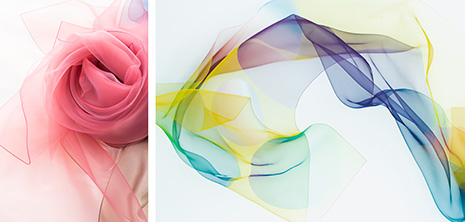
Photo: KOMATSU MATERE Co., Ltd.
“This thread was originally developed for use in plasma TVs***, but it was so thin that it would break easily, making it difficult to weave. Our company, known for its expertise in developing weaving techniques for challenging new materials, received an inquiry from a thread manufacturer about realizing successful weaving with this thread. With our state-of-the-art weaving machines already in place, we began working on developing the weaving technology needed for this thread,” says AMAIKE.
It was determined that the main cause of the ultra-fine thread breaking was static electricity generated by the friction during weaving. To overcome this, the temperature and humidity in the weaving area were carefully managed to reduce static electricity. At the same time, various thread densities and weaving techniques were experimented with, and repeated prototyping and evaluation were conducted. The weaving machines were also upgraded, and their parts modified to handle the ultra-fine thread more effectively.
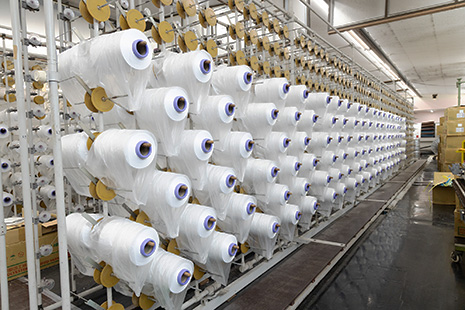
Photo: KOMATSU MATERE Co., Ltd.
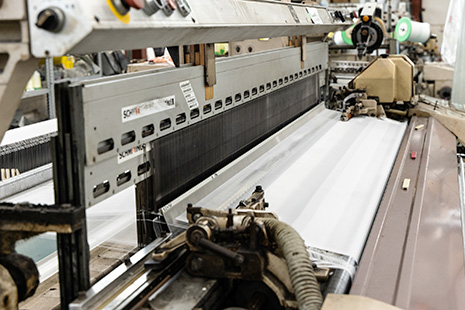
Photo: KOMATSU MATERE Co., Ltd.
“In 2006, after several years of such effort, we succeeded in weaving ultra-thin fabrics and expanded our facilities to begin production. However, about a year later, the client went bankrupt. As a result, we decided to target the fashion industry and undertake product development and sales in-house,” explains AMAIKE.
Since dyeing and sewing are necessary for fashion applications, we tried to outsource these tasks to specialized contractors. However, because the thread was too specialized, it could not be handled effectively by the contractors. As such, dyeing and sewing techniques had to be developed in-house. Adjustments to dye types, moisture levels, and fabric quantities were made through repeated trial and error. For the sewing threads, a thread suitable for ultra-thin fabrics was developed to avoid visible seams, and adjustments to the sewing machines were carried out. As a result, by around 2010, integrated manufacturing from weaving to dyeing and sewing was achieved.
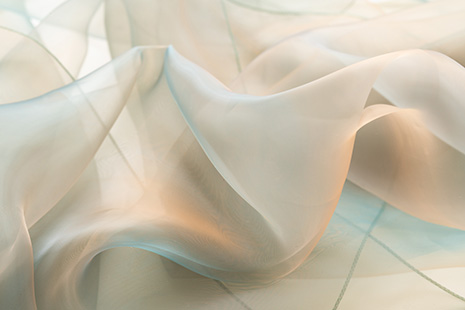
Photo: KOMATSU MATERE Co., Ltd.
“After receiving positive feedback from showing our products to international brands, we began exhibiting at overseas trade shows. This led to an increase in international clients. The unique movement and shine of the fabric have been highly praised, and in recent years, our fabrics have been used by well-known European fashion brands, in costumes for the Paris Opera, and for figure skaters,” says AMAIKE.
In fact, the company is currently suffering from the aftereffects of the major earthquake that struck in January 2024 (the Noto Peninsula Earthquake). The earthquake damaged the factory and equipment, causing production and shipments to stop temporarily. Although production has resumed, repairs to the factory are not yet complete. Nevertheless, the company must continue to move forward with reconstruction, so it is seeking support through crowdfunding services****.
“We will continue to develop new products utilizing our unique fabrics, engaging in communication with our customers, and aim to bring them joy,” says AMAIKE confidently.

Photo: KOMATSU MATERE Co., Ltd.
* Amaike LLC is a group company of KOMATSU MATERE Co., Ltd.
** Organza is a thin, lightweight, and transparent fabric with a crisp texture. In contrast, Amaike Super Organza, also known as Tennyo no Hagoromo, features even greater shine and softness.
*** Introduced in the late 1990s, plasma display televisions were known for their slim profile and high resolution. Although they were considered the mainstream choice for large TVs, by the late 2000s, the shift towards larger LCD displays, due to factors such as cost and energy efficiency, led to LCD displays becoming the dominant technology.
**** Currently featured on the crowdfunding platform ‘Makuake,’ which supports new products and experiences, are scarves and pocket squares from the Tennyo no Hagoromo collection.
By SAKURAI Yuko
Photo: KOMATSU MATERE Co., Ltd.
